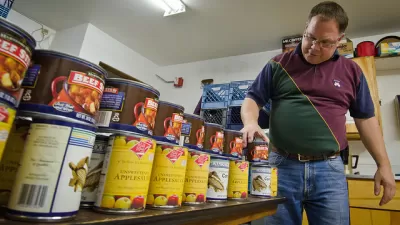Finally, some very, very good news: The U.S. Census released data that shows broad, big gains in household incomes.

The U.S. Census released new income and poverty data this week from the Current Population Survey, making news on many mainstream and planning-related news sites.
Vox, for instance, put out a spate of articles. One by Timothy B. Lee focuses on the disparity in the data for rural areas compared to urban areas. Here, he summarizes the geographic split apparent in the data:
In short, this is proving to be a fundamentally urban economic recovery. Cities are gaining income faster than their suburbs, which in turn are doing better than rural areas. And while suburban households still earn more, on average, than urban households, city-dwellers are closing the gap.
Another Vox article, by Dylan Matthews, frames the data in terms of class. According to Matthews, "the combination of fast income growth at the bottom and slower growth at the top meant that income inequality fell meaningfully between 2014 and 2015. It’s not enough to reverse the huge upward trend in inequality from the 1970s to the present, but it’s progress…"
Writing for CityLab, Kriston Capps begins by proclaiming that the data represents "unambiguously good news." Capps seizes on the three indicators of well-being reported in the Current Population Survey:
In 2015, the official poverty rate fell 1.2 percent. The percentage of people without health insurance decreased as well, reaching an all-time low of 9.1 percent. And to complete the trifecta, real median household income increased by 5.2 percent. If these indicators were colors, they’d be red, white, and blue.
Capps, however, is willing to express caution, in the form of the still-expensive housing market and a reminder that even all this good news has a ways to go to overcome the negative effects of the Great Recession.
For an institutional take on the new data, Jason Furman, Sandra Black, and Matt Fielder summarize six key points from the report for a post on the WhiteHouse.gov blog.
FULL STORY: American cities are getting richer. Rural areas are getting left behind.

Planetizen Federal Action Tracker
A weekly monitor of how Trump’s orders and actions are impacting planners and planning in America.

Congressman Proposes Bill to Rename DC Metro “Trump Train”
The Make Autorail Great Again Act would withhold federal funding to the system until the Washington Metropolitan Area Transit Authority (WMATA), rebrands as the Washington Metropolitan Authority for Greater Access (WMAGA).

DARTSpace Platform Streamlines Dallas TOD Application Process
The Dallas transit agency hopes a shorter permitting timeline will boost transit-oriented development around rail stations.

Renters Now Outnumber Homeowners in Over 200 US Suburbs
High housing costs in city centers and the new-found flexibility offered by remote work are pushing more renters to suburban areas.

The Tiny, Adorable $7,000 Car Turning Japan Onto EVs
The single seat Mibot charges from a regular plug as quickly as an iPad, and is about half the price of an average EV.

Supreme Court Ruling in Pipeline Case Guts Federal Environmental Law
The decision limits the scope of a federal law that mandates extensive environmental impact reviews of energy, infrastructure, and transportation projects.
Urban Design for Planners 1: Software Tools
This six-course series explores essential urban design concepts using open source software and equips planners with the tools they need to participate fully in the urban design process.
Planning for Universal Design
Learn the tools for implementing Universal Design in planning regulations.
Municipality of Princeton
Roanoke Valley-Alleghany Regional Commission
City of Mt Shasta
City of Camden Redevelopment Agency
City of Astoria
Transportation Research & Education Center (TREC) at Portland State University
US High Speed Rail Association
City of Camden Redevelopment Agency
Municipality of Princeton (NJ)





























